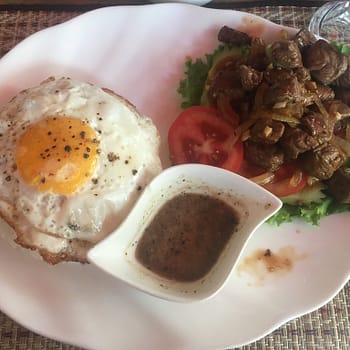,Do we really want to travel in hermetically sealed popemobiles through the rural provinces of France, Mexico and the Far East, eating only in Hard Rock Cafes and McDonald’s? Or do we want to eat without fear, tearing into the local stew, the humble taqueria’s mystery meat, the sincerely offered gift of a lightly grilled fish head? – Anthony Bourdain
I love traveling. Ever since I was a little girl, I dreamed of seeing far away lands and times long past. I distinctly remember asking my dad when the 1980s would come around again. Curious to see what life was like when I was born, I didn’t understand that time was linear. I have very much enjoyed this last year, and especially the last six months, country-hopping and see places I never thought I would.
But traveling is hard. It’s a good thing I love it. It takes a lot to clear your schedule and plan a trip, purchase tickets, pack a bag, figure out how to get around. It takes practice to keep yourself open to experiences, especially if you’re a type-A lover of control like me. At times, travel causes me a lot of anxiety.
Finding Food in Cambodia
As I travel more, I’ve noticed one of the things I’m most consistently anxious about is food and eating. I can handle travel delays – usually – but I hate being sick. (Side note – did you know this is a common phobia? It’s called emetophobia, and I’m not joking when I say I may have it). Suffice it to say that being sick while traveling is often at the forefront of my pre-adventure anxiety. Aside from maybe losing a limb, I can imagine few things worse than being physically ill.
Of course, I take precautions when traveling internationally, particularly in developing countries. If I can’t peel it, I don’t eat it. If it’s raw, I don’t eat it. Even cooked food has the potential to throw me into a worry tizzy, so I typically avoid street foods and stick to restaurants where I see other foreigners.

And don’t get me started on presentation. If it looks like it could walk, fly, or swim off my plate, I’m way less likely to give it a try. Hence why Cambodian tarantulas were not on our menu.
Honestly, it’s a sad way to visit another country. I’m recognizing it and trying to do better, but it’s tough. And it means I miss out on a lot of unique experiences. One of the best ways to truly experience a culture is through their food. But, everybody has their faults – this is one of mine.
Thankfully, a quick google of Cambodian food helped to set my mind at ease. Usually, local cuisine isn’t overly spicy, unlike neighbors Thailand and Vietnam. Offering lots of noodle and rice dishes, I was confident I could eat well while still maintaining a careful distance from potential (and let’s face it, mostly non-existent) danger. Vicki, although also not a lover of spice, is a much more adventurous eater than I am.
Throughout our nine days in Cambodia, we ate at a variety of places, primarily sticking with established restaurants as opposed to street vendors. Our hotel, The Pavilion, offered breakfast every morning as part of our hotel package. With a mix of local and Western flavors, it wasn’t hard to have a different breakfast every morning. We also enjoyed a glass of wine and dessert at the hotel each evening. After spending the day tuk-tuking around in the sun, it was a great way to unwind and process our experiences.
Much to my surprise, Cambodia has a significant French influence, and it’s present in their food for sure. As a French protectorate for 90 years, some cultural overlap is expected. French citizens continue to move into Phnom Penh, with the expatriate rate doubling over the last ten years. French influence can still be seen all around the city, including in some of the places we ate.
The List: My Top 5 Places in Phnom Penh
Open Wine, not far from The Pavilion, was one of the first places we ate in Phnom Pehn. In between meetings, we stop in for the lunch special – an appetizer, main course, and dessert for $14 USD. After walking through the city, we’re not looking our best. Open Wine feels like a swankier place, but the staff welcomes us to be seated. The lunch options have a nice variety, with main courses ranging from salad niçoise to fish. As with most restaurants in Cambodia, you can eat quite well for a low price.
Second on the list is the Rosewood Hotel. With five different dining options, including the Sora Sky Bar, there are lots to choose from for any occasion. This time, we’re dining at Brasserie-Louis. The Rosewood came recommended by one of Vicki’s colleagues, and we stopped in after work one evening. On the 35th floor, we step off the elevator and a hostess greets us. She inquires if we have a reservation. Expecting to be turned away, instead, we are seated near a window overlooking the river. Dinner options at Brasserie-Louis offer French and local cuisine, including the well-known fish amok. Although the wait staff is inconsistent, our dinner is leisurely and enjoyable.
While in Phnom Penh, make sure to check out Phka Slaa Khmer restaurant. Because it’s near our hotel, this spot caught our eye when we first arrived. As an open-air restaurant, Phak Slaa offers traditional Cambodian cuisine with a modern flare. You can find French-inspired dishes, like the Num Pang baguette, and traditional Cambodian tastes like bitter melon soup. I wish we had thought to eat here more than once; Phka Slaa should make your list of Phnom Penh restaurants.
Lot 369 Café and Bar is another must-visit spot. Vicki and I enjoyed lunch here after a volunteer training. Opening in 2015, Lot 369 is socially and environmentally conscious. They ensure their coffee and food is fairly and ethically produced, and even host non-food related events like book exchanges. Although I didn’t indulge in coffee on our visit, I did order a fantastic Buddha bowl for lunch. Lot 369 is often a popular spot, but don’t be turned off by a wait.
Last but not least on the list is Raffles hotel Elephant Bar. I’ll be honest; this one almost didn’t make the cut. It’s expensive ($9 USD for a bottle of water), and it’s a hotel. But, I ultimately decided to list it because I still remember this meal. It wasn’t especially Cambodian – one look at the outside of the hotel, and you’ll know this is a remnant of that 90-year French protectorate status. Vicki and I stopped here after a meeting ran late. Hungry, but knowing it’s hot and we’re walking, we decided to split two entrees: pumpkin and sweet potato salad with chicken, and a burger and fries. Maybe it’s because we’re hungry, but everything about this meal is delicious (except the price tag). While I wouldn’t necessarily put Raffles at the top of your list, it’s an excellent place to stop.
Other recommendations
Obviously, we didn’t only eat at these five restaurants. For convenience, we did have lunch and dinner at The Pavilion occasionally. For their size, they have a decent-sized menu, and I thought the food was consistently good. Other places we ate included:
- The Shop 240 – The Shop has a few locations throughout the city
- Tamarind Mediterranean – located in the popular Street 240 shopping area
- Muse Café and Lounge – nice street view (and ice cream!)
- Juniper Gin Bar – twice!
- Bouchon Wine Bar – go for the drinks, not the food
All in all, Cambodian food in Phnom Penh was a great experience. Thankfully, I never had a dish that was too spicy or too out of my comfort zone (to be fair, that mostly was because of our choice of restaurants). Still, there is undoubtedly something for every palate.
Tell me – have you been to Cambodia? Where are some of your favorite places to eat?



















